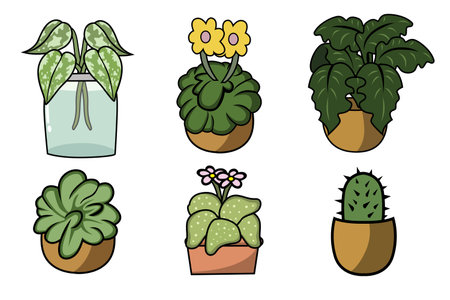1. Understanding Plant Propagation
Plant propagation is the process of creating new plants from existing ones. It’s a fun, budget-friendly way to grow your indoor garden without buying more plants. For houseplant lovers, propagation offers a rewarding experience—watching a small cutting develop roots and become a thriving plant is pretty amazing!
Why Propagate Your Houseplants?
- Save Money: No need to buy new plants when you can grow more from what you already have.
- Share with Friends: Propagated plants make thoughtful, green gifts for family and friends.
- Rescue Struggling Plants: If a plant is dying, you might be able to save part of it through propagation.
- Encourage Growth: Trimming your plant for propagation can also help it grow fuller and healthier.
Common Propagation Methods for Houseplants
There are several ways to propagate houseplants at home. The best method depends on the type of plant you have. Here’s a quick overview:
| Method | Description | Best For |
|---|---|---|
| Stem Cuttings | Cut a piece of stem and place it in water or soil until it grows roots. | Pothos, Philodendron, Tradescantia |
| Leaf Cuttings | A single leaf (with or without stem) is used to grow a new plant. | Snake Plant, African Violet |
| Division | The plant is split into two or more sections, each with roots attached. | Peace Lily, ZZ Plant, Ferns |
| Pups or Offsets | Small baby plants that grow around the base of the parent are separated and replanted. | Aloe Vera, Spider Plant, Succulents |
| Air Layering | A section of stem is encouraged to root while still attached to the parent plant. | Rubber Plant, Fiddle Leaf Fig |
Choosing the Right Method
If youre just starting out, stem cuttings in water are one of the easiest and most satisfying methods. You’ll get to watch the roots grow day by day! Once you’re comfortable, try out other techniques based on your plant collection. As we go deeper into each method in upcoming sections, youll learn exactly how to do them step-by-step.
2. Essential Tools and Materials
If youre just starting out with plant propagation, having the right tools on hand can make the process smoother and more successful. You don’t need anything fancy—just a few basic supplies to get going. Here’s what you’ll need to propagate your houseplants indoors:
Basic Propagation Supplies
| Tool / Material | Description |
|---|---|
| Sharp Scissors or Pruning Shears | Used to take clean cuts from healthy plants. Clean blades help prevent disease. |
| Potting Mix | A lightweight, well-draining mix is ideal. Look for mixes labeled for indoor plants or seed starting. |
| Small Containers or Pots | Use small plastic pots, nursery containers, or even recycled yogurt cups with drainage holes. |
| Glass Jars or Vases (for water propagation) | Clear containers let you watch root development when propagating in water. |
| Rooting Hormone (optional) | This powder or gel encourages faster root growth, especially helpful for woody stems. |
| Spray Bottle | Keeps soil moist without overwatering; also useful for maintaining humidity. |
| Plastic Bags or Humidity Dome | Covers to retain moisture and create a mini greenhouse effect for cuttings. |
Choosing the Right Potting Mix
A good potting mix is key to successful propagation. Avoid using garden soil—it’s too heavy and may contain pests. Instead, choose a sterile mix that drains well. You can even make your own by combining equal parts peat moss (or coco coir), perlite, and vermiculite. This creates a light, airy environment where roots can grow easily.
Containers That Work Best Indoors
You don’t have to spend a lot on containers. Anything clean with drainage holes will do. Some popular options include:
- Plastic nursery pots: Lightweight and reusable.
- Terracotta pots: Great for airflow but may dry out faster.
- Mason jars or glass cups: Perfect for rooting cuttings in water.
Tips for Keeping Tools Clean
Always sanitize your cutting tools before and after use. You can wipe them down with rubbing alcohol or soak them in a bleach solution (1 part bleach to 9 parts water). This helps prevent spreading diseases between plants.
Quick Tip:
If youre using recycled containers, make sure to wash them thoroughly with soap and hot water before planting. Rinse well to remove any residue that could harm young roots.
Next Up: Choosing the Best Plants to Propagate (Part 3)
Now that you’ve got your tools ready, it’s time to pick the right plants to multiply! Stay tuned for tips on which houseplants are easiest—and most rewarding—to propagate at home.

3. Best Houseplants for Beginners to Propagate
If youre new to plant propagation, starting with easy-to-grow houseplants can help you build confidence and enjoy quick success. Some plants are naturally more forgiving and adapt well to home environments, making them perfect candidates for beginners. Heres a look at some of the best houseplants that are both beginner-friendly and super easy to propagate.
Pothos (Epipremnum aureum)
Pothos is often called the “gateway plant” because it’s incredibly low-maintenance and quick to root in water. Just snip a vine right below a node (the bump where leaves grow), place it in water, and wait for roots to appear in a couple of weeks. Once the roots are a few inches long, you can transfer it to soil.
Snake Plant (Sansevieria)
Snake plants are stylish and tough, making them ideal for busy or forgetful plant parents. To propagate, cut a healthy leaf into 2-3 inch sections, let them dry for a day or two, then place the bottom end into moist soil. Be patient—snake plants take longer to root but are worth the wait.
Succulents
Succulents like echeveria or jade plants can be propagated using just a single leaf or cutting. Gently twist off a healthy leaf, let it dry out for a few days until calloused, then place it on top of well-draining soil. Mist lightly every few days until roots and tiny new plants begin to form.
Quick Comparison: Easy Houseplants to Propagate
| Plant Name | Propagation Method | Time to Root | Best Growing Medium |
|---|---|---|---|
| Pothos | Stem cuttings in water | 1–2 weeks | Water first, then soil |
| Snake Plant | Leaf cuttings in soil | 4–8 weeks | Well-draining potting mix |
| Succulents | Leaf cuttings on soil surface | 2–4 weeks | Cactus/succulent mix |
Tips for Success:
- Use clean, sharp scissors or pruning shears when taking cuttings.
- Label your propagations so you remember what’s what.
- Avoid overwatering—most cuttings prefer slightly moist conditions while rooting.
- Keep your propagations in a warm spot with indirect light for best results.
Starting with these easy houseplants will make your propagation journey fun and rewarding. With just a little time and care, youll soon have more greenery than you know what to do with!
4. Step-by-Step Propagation Methods
Ready to grow your plant collection without spending a dime? Propagation is the way to go! Below, youll find beginner-friendly instructions for three of the most popular and effective propagation techniques: stem cuttings, leaf cuttings, and division. Whether youre working with pothos, succulents, or peace lilies, these methods will help you multiply your houseplants right at home.
Stem Cuttings
This is one of the easiest and most common ways to propagate many vining or bushy houseplants like pothos, philodendron, and coleus.
What You’ll Need:
- Sharp scissors or pruning shears
- A healthy parent plant
- Small container with water or potting mix
- Optional: rooting hormone
Steps:
- Select a healthy stem with at least 2-3 leaves.
- Cut just below a node (where the leaf meets the stem).
- Remove the lower leaves, leaving at least one leaf on top.
- (Optional) Dip the cut end in rooting hormone.
- Place the cutting in water or moist potting soil.
- Keep in a warm spot with indirect sunlight and wait for roots to form (usually within 1–3 weeks).
Leaf Cuttings
This method works well for plants like snake plants and many types of succulents. It’s a fun and simple way to grow new plants from just one leaf!
What You’ll Need:
- A mature, healthy leaf
- Clean knife or scissors
- Cactus or succulent soil mix (for succulents)
- Shallow tray or small pot
Steps:
- Cut a healthy leaf cleanly from the base of the plant.
- If using succulents, let the leaf dry out for a day or two to callous over.
- Lay the leaf flat on soil or insert it upright into moist soil depending on plant type.
- Mist lightly every few days to keep soil slightly moist but not soggy.
- Tiny roots and new growth should appear in a few weeks.
Division
This technique is perfect for clumping plants like peace lilies, ferns, and ZZ plants. If your plant has multiple stems coming from the soil, it might be ready to divide!
What You’ll Need:
- The parent plant ready for repotting
- A clean knife (if needed)
- Pots with fresh potting mix
Steps:
- Gently remove the plant from its pot and shake off excess soil.
- Look for natural divisions—clusters of stems with their own roots.
- Carefully separate sections by hand or use a knife if they’re tightly packed.
- Plant each section in its own pot with fresh soil.
- Water lightly and place in indirect light until established.
Quick Comparison Table
| Method | Best For | Time to Root | Difficulty Level |
|---|---|---|---|
| Stem Cuttings | Pothos, Philodendron, Coleus | 1–3 weeks | Easy |
| Leaf Cuttings | Sneake Plant, Succulents | 2–6 weeks | Easy to Moderate |
| Division | Peace Lily, Ferns, ZZ Plant | N/A (already rooted) | Moderate |
No matter which method you choose, patience is key. Keep an eye on moisture levels and provide plenty of indirect light. Before you know it, you’ll have brand-new plants ready to brighten up your home—or gift to friends!
5. Caring for New Plant Babies
Now that youve successfully propagated your houseplants, its time to give your new plant babies the love and care they need to thrive. Proper care during this stage is essential to help them develop strong roots and grow into healthy, mature plants. Heres what you need to know.
Watering Your Propagated Plants
Newly propagated cuttings are more sensitive to overwatering and underwatering than established plants. The key is to keep the soil or growing medium slightly moist but not soggy. If youre rooting in water, change the water every few days to keep it fresh and prevent bacteria buildup.
Watering Tips:
- Use a spray bottle for gentle watering if using soil or moss.
- Stick your finger about an inch into the soil—if it feels dry, its time to water.
- Avoid letting the container sit in standing water.
Light Requirements
Your baby plants need light, but not too much! Bright, indirect sunlight is best while theyre still developing roots. Too much direct sun can stress or burn tender new leaves.
Best Light Conditions by Plant Type:
| Plant Type | Ideal Light |
|---|---|
| Pothos | Bright, indirect light |
| Snake Plant | Low to bright, indirect light |
| Spider Plant | Indirect sunlight or filtered light |
| Monstera | Medium to bright, indirect light |
Signs of Successful Rooting
It’s exciting to see signs that your cuttings are taking root! Here are some indicators that things are going well:
- New growth: Leaves or stems starting to sprout is a great sign.
- Resistance when tugged: Gently tug the cutting—if there’s resistance, roots are forming.
- No signs of rot: Healthy roots should be white or light tan, not mushy or dark.
When to Pot Up Your Cuttings
If youve been rooting in water or sphagnum moss, wait until the roots are at least 1-2 inches long before transferring them into soil. Be gentle during transplanting and use a small pot with good drainage and appropriate potting mix for the plant type.
Quick Tip:
You can mix a bit of perlite or orchid bark into regular potting soil to improve aeration for young roots.
Treat these baby plants like any other living thing—they may be small now, but with a little patience and care, theyll grow into beautiful additions to your indoor jungle!
6. Common Mistakes and How to Avoid Them
Even though plant propagation can be fun and rewarding, beginners often run into a few common issues. Don’t worry—it’s all part of the learning process! Below are some frequent mistakes and tips on how to avoid them so you can successfully grow your plant family with confidence.
Using the Wrong Tools
One of the most common mistakes is using dull or dirty tools. This can damage your plant and even spread disease. Always use clean, sharp scissors or pruning shears when taking cuttings.
Tip:
- Wipe tools with rubbing alcohol before and after each use.
- Use sharp blades to ensure clean cuts that heal faster.
Choosing Unhealthy Parent Plants
Your new plant will only be as healthy as the one it came from. If you take a cutting from a weak or diseased plant, chances are the new growth wont thrive either.
Tip:
- Select mother plants that are pest-free, vibrant, and actively growing.
- Avoid propagating from plants that are stressed or recently repotted.
Improper Cutting Techniques
Cutting too much or too little can affect whether your propagation succeeds. Different plants require different methods—some need node cuttings, others root best from leaves or stems.
Quick Reference Table:
| Plant Type | Best Propagation Method |
|---|---|
| Pothos | Stem cutting with nodes |
| Succulents | Leaf cutting |
| Spider Plant | Pups (baby offshoots) |
| Schefflera | Stem cutting |
Poor Watering Habits
A common beginner mistake is overwatering or underwatering propagated cuttings. Too much water can lead to rot, while too little will dry them out before they root.
Tip:
- If propagating in water, change the water every few days to keep it fresh.
- If using soil, make sure its moist but not soggy—think of a wrung-out sponge.
Lack of Patience
Propagation takes time! Some plants root in just a week, while others may take several weeks or even months. Impatience can lead to poking at roots too soon or giving up too early.
Tip:
- Create a simple propagation journal to track progress weekly.
- Avoid disturbing the cuttings—let nature do its thing!
Avoiding these common pitfalls will help set you up for propagation success. With a bit of practice and care, you’ll be turning one houseplant into many in no time!


